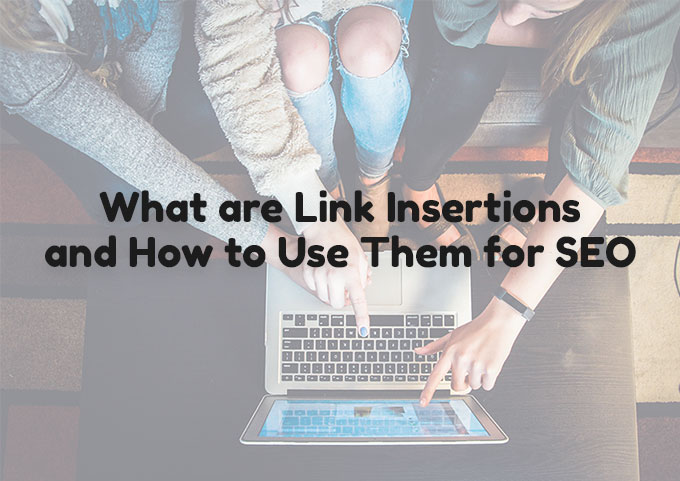
Link building is the process of acquiring hyperlinks from other websites to your own.
A hyperlink (usually just called a link) is a way for users to navigate between pages on the internet. Search engines use links to crawl the web; they will crawl the links between the individual pages on your website, and they will crawl the links between entire websites.
But most importantly for SEOs, link building is used to improve page rankings on your website. Today, we’re going to specifically talk about one of the most popular link building strategies: link insertions.
What are link insertions?
Instead of creating new content or guest posts, link insertions involve adding relevant and valuable links within the context of an already published article or webpage.
Here is an example. Let’s say I’m marketing a calendar scheduling software and trying to build links to my homepage.
I might approach a website like HubSpot and request my calendar app be added to a blog post where they have a list of appointment scheduling apps.
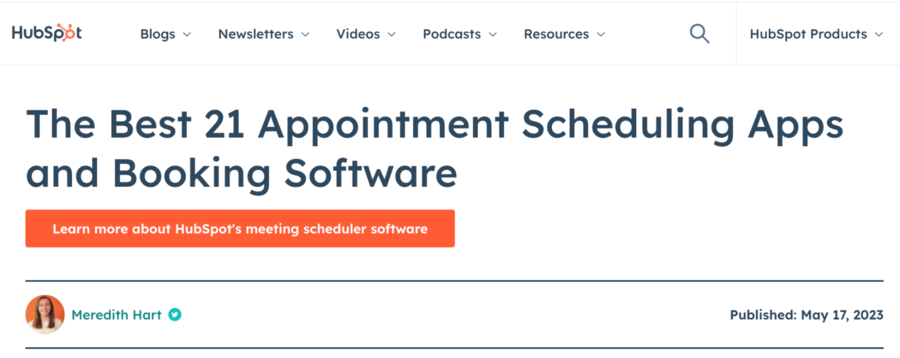
If I was able to convince them to add a link to my website, that would be an example of a link insertion. With the inserted link, they gain a valuable resource on their page and I get the link juice from Hubspot, which allows my page to rank better in Google search results. Everybody wins.
What type of backlinks are good for SEO?
Not all links are created equal and they carry different values.
So, what makes a good link?
- Authority
The greater the website’s Domain Rating (DR) the more value the link will have once somebody links to your website.
For example, a link from nytimes.com will have a lot more value than a link coming from a brand-new website.
The Domain Rating of the New York Times’ website, as measured by Ahrefs is 94.

- Relevance
The more relevant the link is, the more value it will have.
Topical relevance can come from the topic of the entire website you get a link from. It can also originate from the topic of the individual blog linking to your website, the surrounding sentence/text to your link, and the physical location of the website. For example, a website that specializes in content for Arizona would be a highly specialized location.
A few examples of a link having more value:
- A Michigan-based construction company getting a link from another local construction company, rather than a tourist agency or a general news website.
- A jewelry store getting a link insertion from a blog about engagement rings, rather than a blog about coffee.
3. Link Placement
Google’s reasonable surfer patent talks about a link having more value if the likelihood of being clicked on is greater.
For example, links are more likely to be clicked on if:
- They are in the content and not in the footer/header/sidebar of the website.
- They are placed higher on the page.
- There aren’t too many other links accompanying it on that page.
So, you want to get links from a website that will link to you somewhere high up on their blog or page.
4. Destination
Ideally, you would want a website to link to the pages you want to rank on Google. For example, if you’re trying to rank a page for rug cleaning services, you want a backlink to that page and not an unrelated page on rug maintenance.
As we discussed, backlinks should help those pages rank higher on Google for your targeted keywords.
You also want websites to link to your home page, that’s how you improve your website’s Domain Rating and Domain Authority.
You want to also link to product or service pages that are most likely to drive revenue for your business. For example, if you sell a lot of phone chargers and you know that one page is driving revenue through search engines, you want to build relevant links to that page.
5. Organic Traffic
The link insertions you build should be from real, valuable websites. If the websites aren’t ranking well on their own for organic search, how is that website going to pass much link value to your website?
Just type your website into the Site Explorer tab in Ahrefs and review the organic traffic metrics:
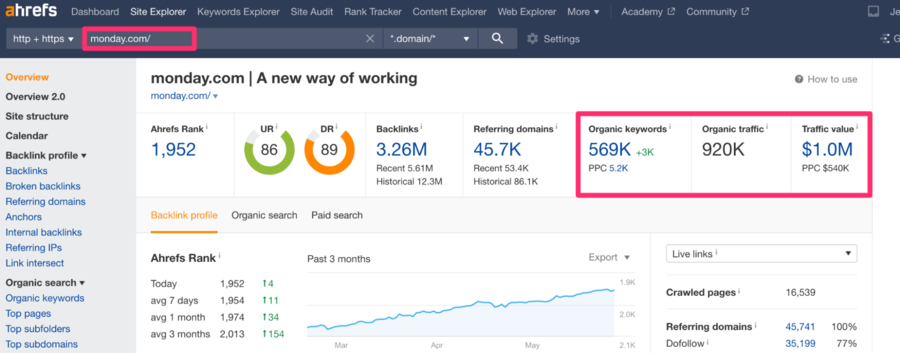
We recommend a minimum of 1,500 organic visitors for the entire website, as measured by Ahrefs. However, the more, the better.
How to find link insertion opportunities
The first step to getting high-quality link insertions is to build a list of potential websites you would like to get backlinks from.
One of the best strategies for this is by doing competitor backlink analysis. This strategy includes researching what backlinks your competitors have from existing content and trying to secure those links for your website. Read this article to learn how!
What kind of link criteria should you use when building links?
Website criteria are very important. You want to make sure the link insertions you build are valuable and help improve website rankings.
We start with the following link criteria for any client and will adjust if our clients have more specific requests:
Excluded sites:
- Sites with Ahrefs domain rating less than 30
- Websites that publish content way off topic compared to your website
- Websites that publicly advertise selling links
- Blogspot, Weebly, Squarespace, and other free blogger site domain names
- Forums
- Wiki pages
- Websites that aren’t written in English
- Sites with adult and questionable content such as drugs, casinos and porn.
Let’s jump into how you actually review link criteria content and find high authority websites.
Check website Domain Rating
The first step to identify whether a website is DR30+ is to check it in your outreach list.
Here is the procedure we use to check the domain rating in Ahrefs.
- Log in to your Ahrefs account
- Insert the website address in “Domain or URL” field or “batch analysis” and click the search button. Check and verify if the domain rating value is above 30.
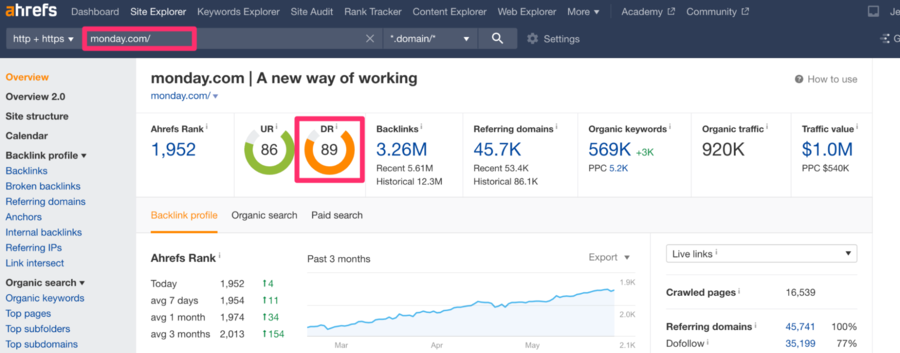
Check for topical relevance
You should perform a site search in order to determine whether the website publishes sketchy or unrelated content.
Here are a few examples of content you need to avoid (unless your website is in these areas):
- Sites with casino/gambling content
- Sites with NSFW (not safe for work) content, such as porn, sex, viagra, etc.
- Sites that publish THC/CBD related content
- Sites that have more than 3 categories that are not relevant to your niche
You can quickly check whether a website you’re considering publishes sketchy content by using the site search.
Let’s take this site for example https://www.xaasjournal.com/
If we go to the search bar and type in the keyword “casino”, we will notice that this site doesn’t have casino-related content and by that criteria, it passes. There are no high-quality backlinks that can come from these pages.
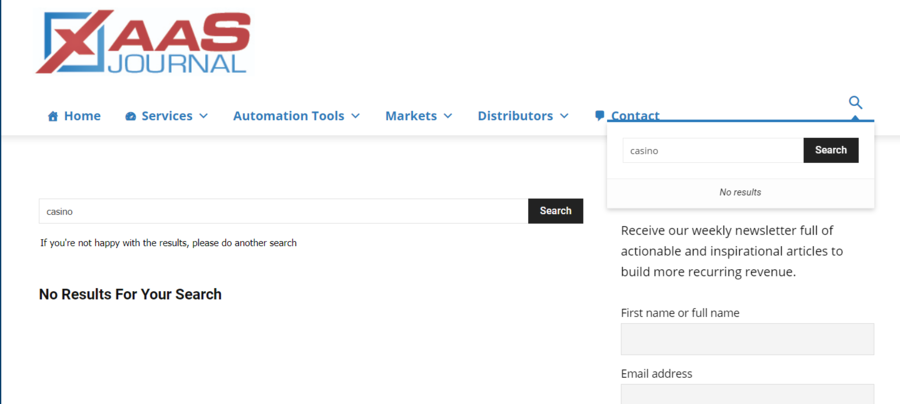
If “casino” or any other keyword pops up in an article’s search results, you will notice those articles listed.
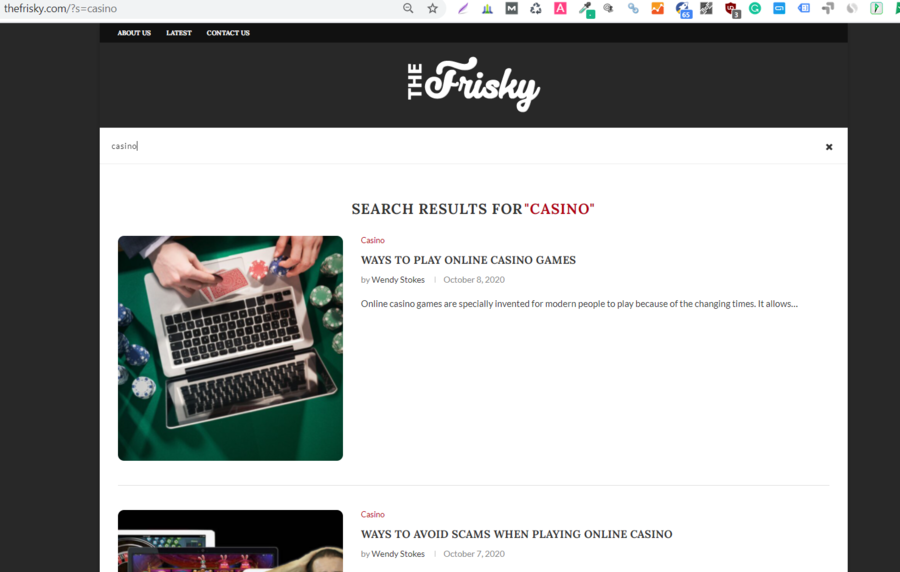
Websites that have more than 3 categories that don’t fit your website’s content, should be excluded from your link insertion campaign.
For example, the website below has health, celebs, movies, relationships, etc.
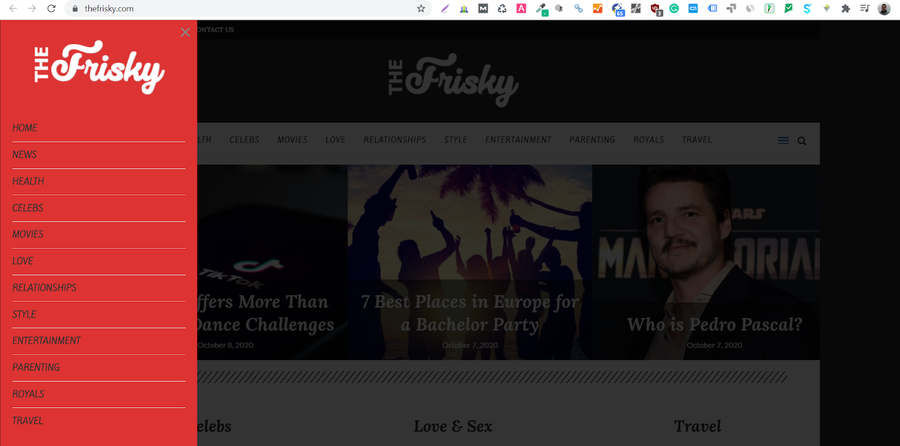
Advertise pages on websites
Advertise pages are usually located in the header or footer sections of websites.
Here you may find examples of websites containing an Advertise page in their header:
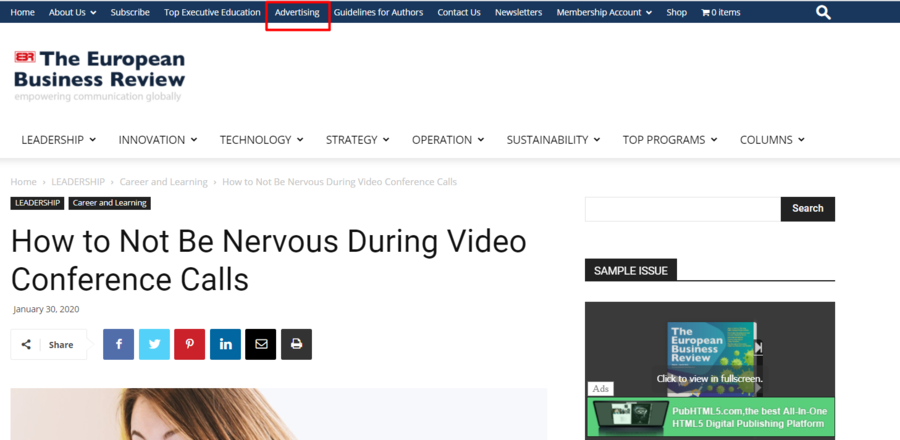
Footer:
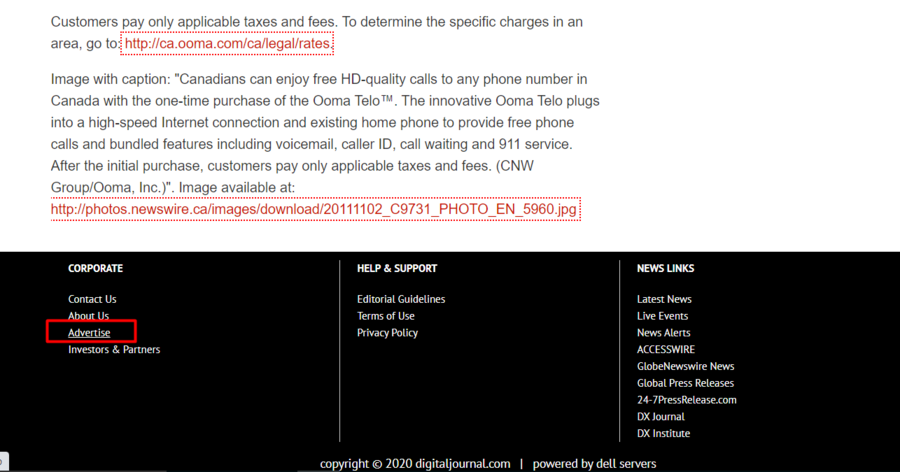
Websites should be eliminated if they have an Advertise page and additionally say that they:
- Sell links
- Sell guest posts
- Or sell sponsored posts
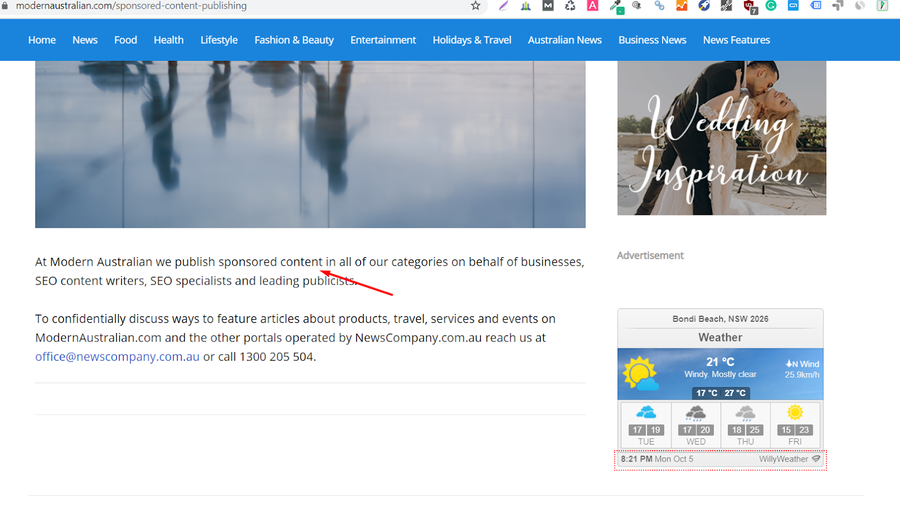
Free blogging sites
While the DR of websites like Squarespace, Weebly, etc. look strong, anyone can create subdomains on those types of sites. These links are not valuable for your link profile.
If anyone can easily build pages and links on sites like this, the links become low-quality so you should avoid them in your link insertion strategy.
Here are some examples of free blogging sites:
- Pizzanine.squarespace.com
- Weyburnpubliclibrary.weebly.com
- Securityskeptic.typepad.com
- Lovescihub.wordpress.com
- Elemental.medium.com
- Daikinairservice.blogspot.com
While they might seem impressive if you analyze them through a tool such as Ahrefs, these websites have little to no value in terms of links. If someone offers link building services to you and lists these as an example of their work – walk away.
Forums and Wiki Pages
Similar to free blogging sites, anyone can add links on forums or wiki pages, making them pretty invaluable. Don’t waste your time building links from those pages and beware if link builders use that tactic with your website.
Finding contact information at those websites
Before you start with email finding, you should perform a brief website analysis in order to find the best possible person to contact.
Finding a person behind an email address is an important step in your personalized outreach. If you know the name, the chances that you will get a response from them are going to be much higher.
Think about it: you too probably feel more inclined to respond to an email that is from someone you do not know, but this person is addressing you directly.
Bear in mind that very often you will find a general email address on the website that might be good for your outreach (e.g. [email protected]) but finding a personal contact is better.
You are going to want to find the actual person in charge of content creation or maybe even SEO for a very simple reason: they will know what you are talking about and whether you can collaborate or not.
Usually, you should contact:
- Editors
- The person who is in charge of content marketing or SEO strategy
- The person who is in charge of content writing
- The person who wrote the article – only once you’ve verified the person still works at the company and they are not freelance writer hired for occasional collaboration for a specific piece of content
- Site owners – only if the website has a small number of people in their teams <10 (usually you can make sure of this by checking the ABOUT section)
Very often, you will notice that article authors are usually employed as content marketers or writers at companies.
If you notice on the website that it has one or two owners, you should take a detailed look into them and find out who is responsible for content edits.
Sometimes, general emails such as [email protected] are assigned to specific people in websites’ teams, and you can freely send emails by using their names in personalized outreach.
If you find the name of a person who is in charge of content edits on the site, or if you have verified that the article author works on the site and is in charge of content edits as well, you can try to find their emails. You can do this by using email finding tools listed in the “Use contact finding tools” section below.
By knowing their names only, you can step into the procedure to find their email addresses as well by using the tools that we provided.
The following pages are generally good to look for contact information:
- Contact Us page
- About Us page
- Team pages
- About pages
Here are some good and bad examples of email addresses:
| Good | Bad |
| [email protected] | [email protected] |
| [email protected] | [email protected] |
| [email protected] | [email protected] |
| [email protected] | |
| [email protected] | |
| [email protected] |
Note: The table shows just example addresses. You shouldn’t apply these patterns automatically. In other words, you should not contact websites by using [email protected] without even verifying on the website whether that address exists or not.
If “Bad” website addresses are the only contacts you can find on a target website, then you should proceed and use them instead.
Checking header and footer areas
One great tip for finding an email address is to check the header and footer areas on the site. The header is the top section of the website, while the Footer section is the bottom one.
It’s a common practice to use those website areas to include links to contact pages, and social media (e.g. Facebook) or to place contact information by using some of the icons.
Below, you may find several screenshots that further explain this:
Here is an example of a header containing a menu with links to the Contact page and Social media pages such as Facebook:
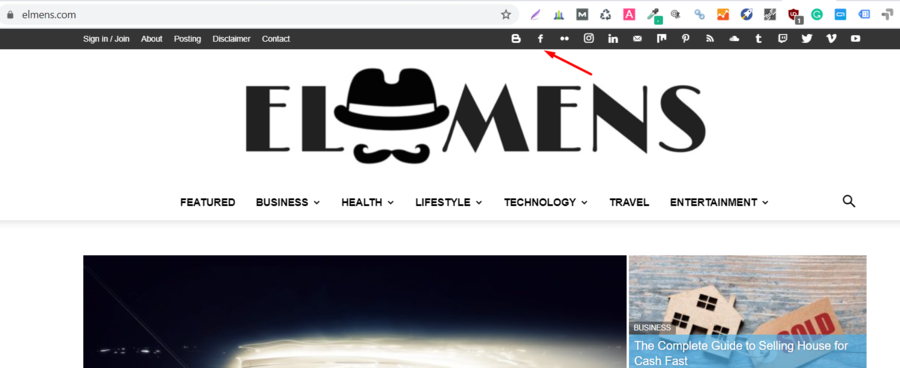
Here is an example of a footer area containing email addresses but also links to social media:
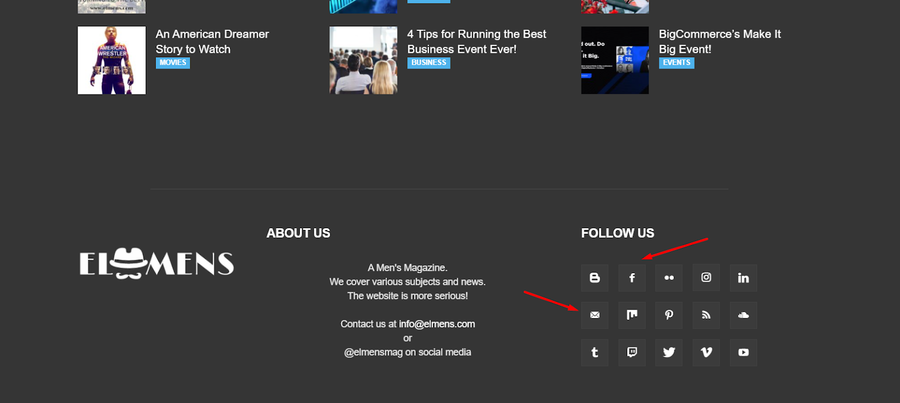
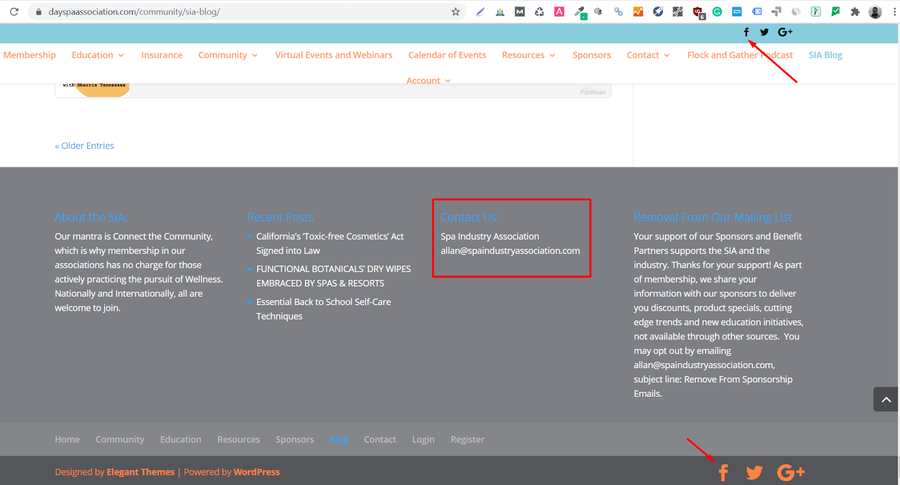
Check Facebook pages
You may have noticed we emphasize the importance of finding a link to a website’s Facebook pages, which might also be a good spot to find contact addresses of the site.
Here is the procedure on how to find email address by using a website’s official Facebook page:
- Find a link to the website’s Facebook page (usually, it’s an icon)
- Visit the page
- Take a look at the About section and see if there is contact information there or not
- If there is no contact information, you do not have to look any further on Facebook.
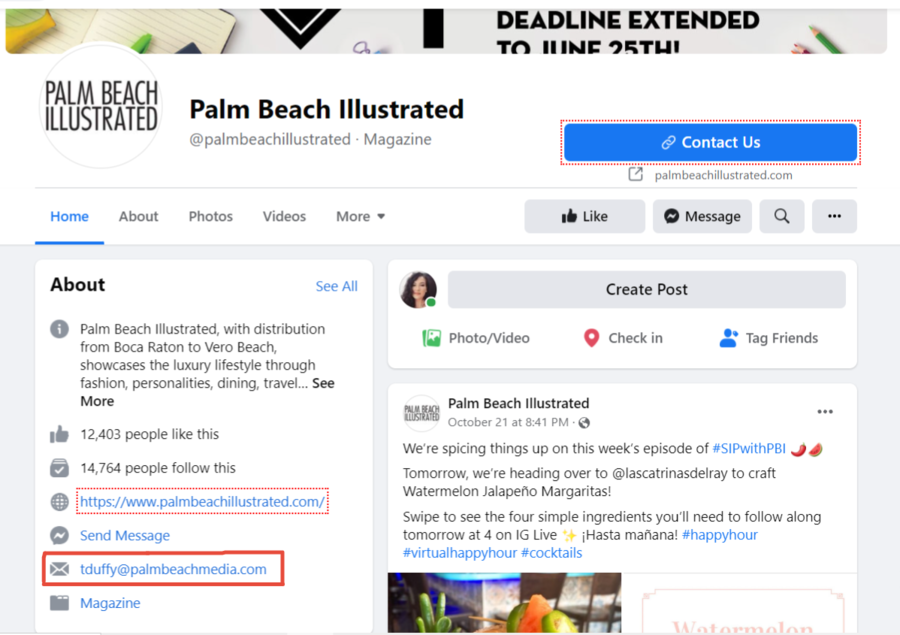
For some websites, the email address displayed on their Facebook page can contain the name of the team member.
In this case, it is not a bad idea to go back to the ABOUT US or TEAM section and see if you can find what that person is in charge of, to make sure they are suitable for outreach.
Use contact-finding tools
Finding a person behind an email address is an important step in your personalized outreach. If you know the name, the chances that you will get a response from them are going to be much higher.
If you find the name of a person who is in charge of content edits on the site, or if you have verified that the article author works on the site and is in charge of content edits as well, you can try to find their emails by using email finding tools listed in “Use contact finding tools” section.
Just by being familiar with their names, you can step into the procedure to find their email addresses as well by using the tools that we provided.
We encourage you to use contact finding tools, such as Hunter, VoilaNorbert or SalesLQ, which can quickly provide you with the right contact information.
First, target the site you’d like to explore contact-wise. Then copy the website’s URL (ending at the home page’s final extension (*.com, *.io, etc.) and enter in the space provided below the designated Domain search. This works the same in pretty much all of the tools mentioned above. Here is an example from Hunter.
Hunter.io:

Once done, the tool will list the contacts available.
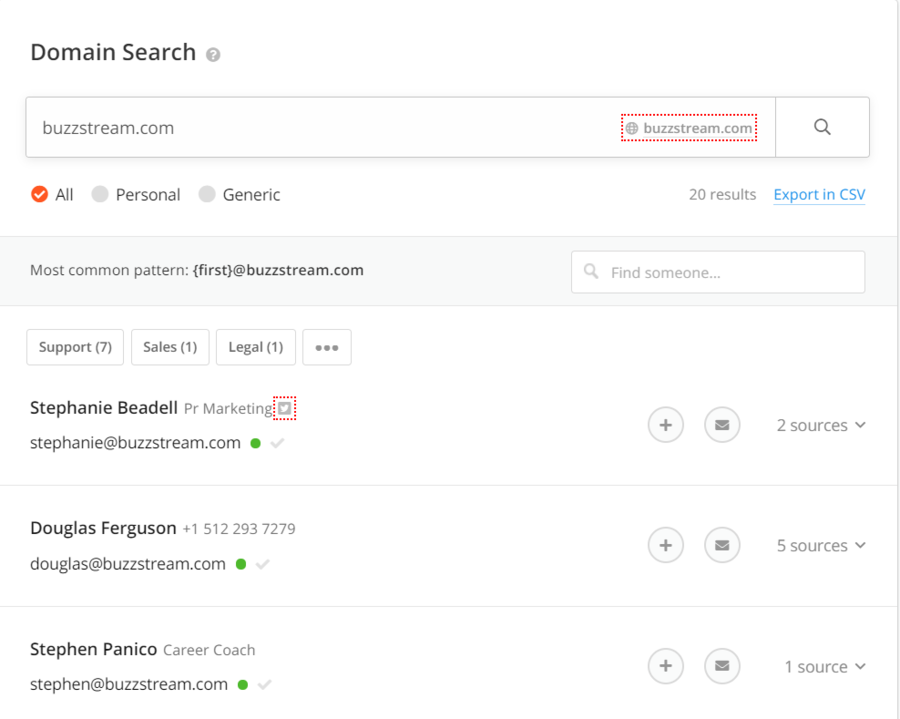
As you can see, below the search engine, you have the opportunity to check three options:
- All – which will allow you to see all the contacts from a specific website
- Personal – which will show you only the contacts by the actual name of the person
- Generic – which will show you general email addresses such as info@… , support @…

Depending on your needs, choose the ones that will, in your experience and according to your purpose, yield the most effective results.
It might happen that the tool will have no results to offer on topically relevant website.

In that case, search the page for contact information, or some of the website’s available social media channels.
Hunter works as a Chrome extension as well, so you can conveniently install it next to your browser’s search bar for quicker access.

The probability of reaching the right person is shown by the dot you’ll find next to the contact.
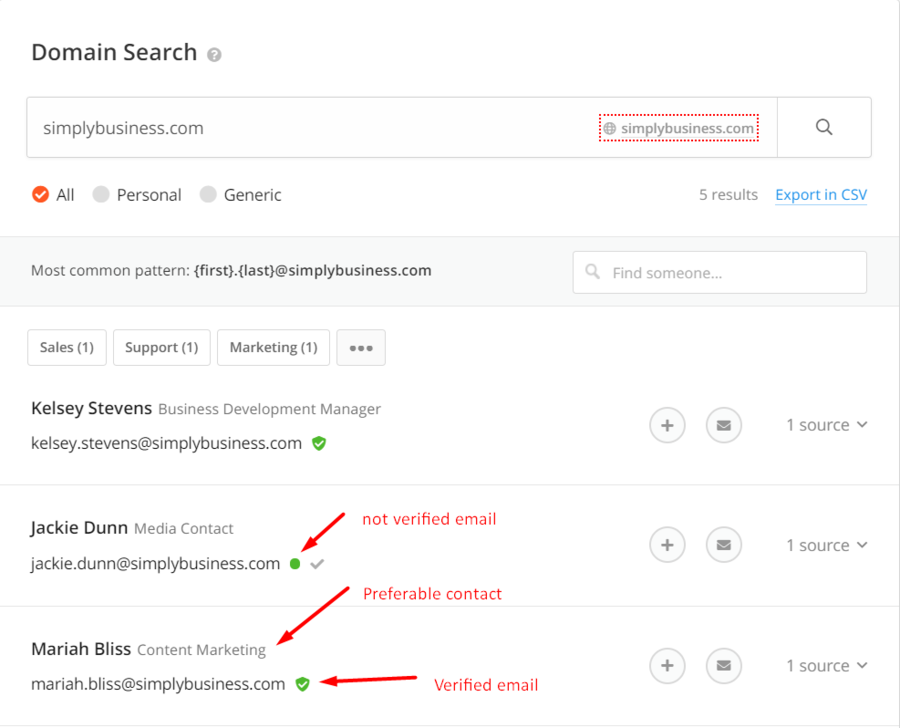
If the dot is green, there’s a high possibility that the email is active and you can check the actual percentage by hovering your mouse over it. However, if the dot is yellow, chances are the address is no longer in use.
Green dots mean that chances are high but the email is not verified.
If you hover over the little check symbol it will tell you whether the address can be verified or not. In cases where it cannot be verified, there is still a big chance the email address is correct because this tool does not make mistakes very often.
However, when there is absolute certainty your email will reach the recipient, you’ll see a different sign with a checkmark on it meaning that the address has already been verified.
As far as contacts go, oftentimes you’ll be able to see the person’s role in the company next to the name. Try to aim for people working in digital/content marketing, editors and content specialists (as shown above).
If there is no position listed next to the name, you might be better off going with a generic email option (where you might find editor@…com) since otherwise, you might contact someone in accounting, finance, or software development who will not answer nor forward your email to the person in charge.
Always remember that link building is very specific, and not many people will understand what we are looking for. For these reasons, a person in accounting will most likely ignore your email, because it is possible they do not even know who to forward it to.
VoilaNorbert
VoilaNorbert is another great email-finding tool that lets you search email addresses within the domain name.
It gives you 50 free searches.
The only pre-requirement that you will have to have is to find out the first and last N+name of a person who works at the website you want to contact. That’s something you can often find under by looking at a blog author, about page, team page, etc.
The procedure of finding an address is pretty straightforward.
After you’re logged in, you should enter the first and last name of the person you want to contact and the domain address:
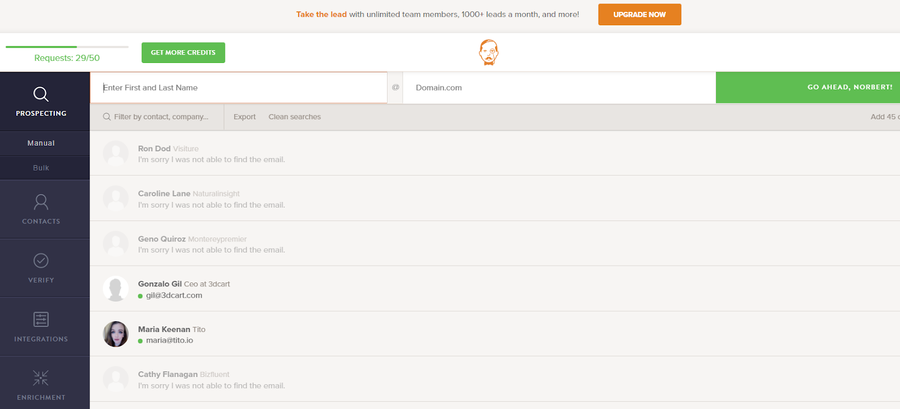
After you’ve entered your first and last name and the domain name, just click the “Go ahead, Norbert” button and start searching for contact information.
If the contact is found, you will see a green dot displayed beside an email address. If not, the search request will be grayed out.
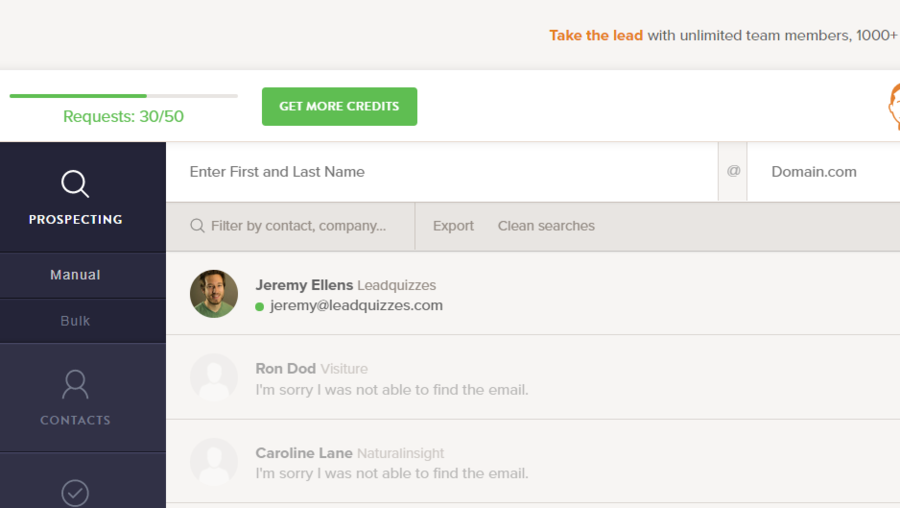
SalesQL
This is a tool that lets you find contact addresses by using prospects’ LinkedIn profiles.
If you register for free, you will get 100 search credits/month for the search.
But let’s quickly cover it.
- After you’ve registered, you’re required to Install their extension for Google Chrome.
- Once you’ve installed the extension, all you have to do is go to the LinkedIn profile of the person you want to contact, click the Icon and the tool will do the job for you.
If all else fails, you may send your email through the Contact form on the website.
Make sure you also send a copy of the email to yourself in order not to forget to follow up (more about this in the section on the link building process).
How to choose link insertion placements
In this section, you will learn how to perform a site search in order to find the best possible article for your website
The article content must match your target URLs and must be relevant to the services on those pages.
It’s very likely you will find only a section of the article that is relevant to the topic of your page, which is also a good way to go if you are unable to find a 100% matching article.
You can perform a site search by using:
- Site search box to find a piece of relevant, quality content
- Google Search operators to detect possible bad content
Let’s see how both work.
Site Search Box
Being that “Site search” has already been covered in the “Sketchy content” section, which you can find in the “Website Criteria” section of this file, we will quickly go over this criteria once again.
When performing a “Site search” by using a search box on the website, you can type in keywords that are relevant to you and your website.
For example, if you’re doing outreach for a VOIP-related client, you can type in keywords that are relevant to their business, such as VoIP, business communication, communication, remote teams, etc.
These words will help us find the article as well as the ideal anchor text immediately. If we have no luck with exact hits, we can try other searches that will help us find an existing article with a suitable topic.
For example, if our client is offering CPR training and there is no article that contains this exact phrase, we can search for ones mentioning nurses as well or car accidents.
Once we find an existing page with a suitable topic, we can proceed to add a couple of sentences that will fit naturally and contain the anchor text we originally needed.
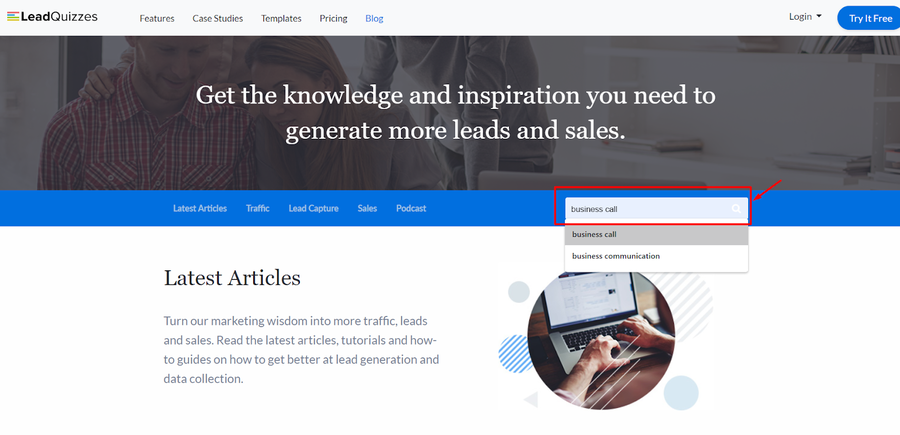
Using Google search operators
This can often be a more effective way to perform a site search. You can use Google to check for specific phrases or keywords throughout the entire website.
The SERP results will immediately show you where exactly in the article your desired keyword is. This is very convenient because a search on the website might not have this type of result. Alternatively, it might offer you articles that contain just one out of two words you were looking for.
For example, you will see articles containing the word “business” and not “business communication”, the prior not being enough because it is too general.
There are several types of Google search operators, but we will focus only on using one:
intext:”Type in Keyword or Phrase” + inurl:”domain.com”
This function searches for the specific keyword that you need within domain.com website content.
Let’s take a look at this real-life example:
If you’re promoting a VOIP-related client and find leadquizzes.com as a website as a good candidate for a backlink, you can proceed with searching LeadQuizzes’ website content for keywords that you might use for that client’s backlinks.
intext:”business communication” + inurl:”leadquizzes.com”
In this example, we used “business communication” as a keyword for checking whether that keyword/phrase is located on leadquizzes.com website or not.
From the example shown below, you will notice that there are two potential articles that we could use for our backlink:
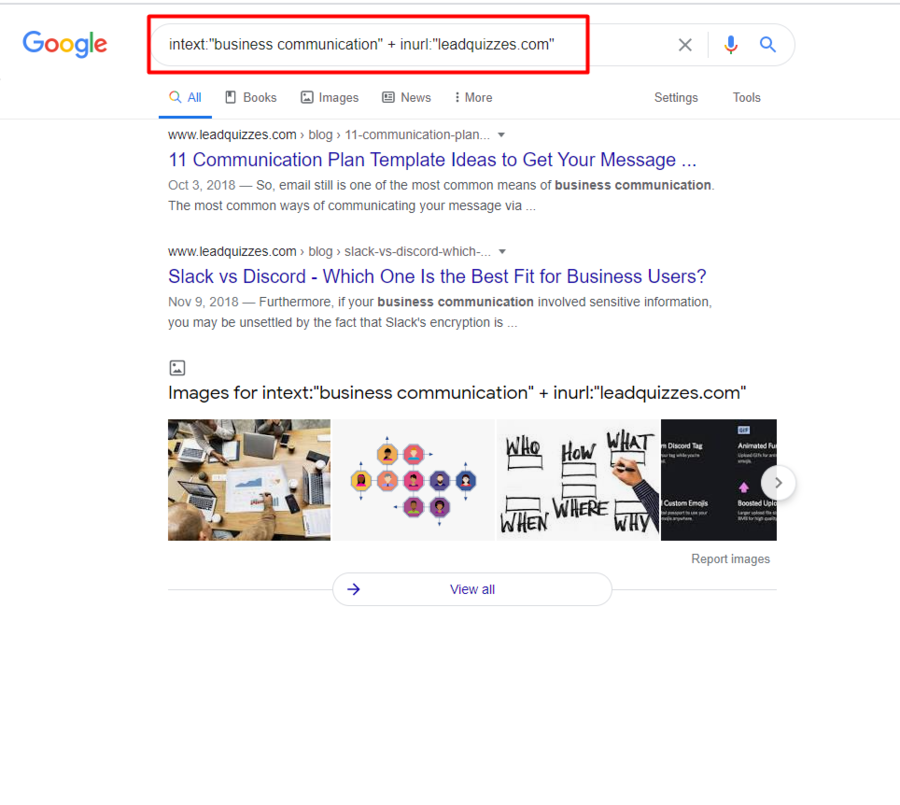
How to choose your link insertion anchor text
An anchor is a text you click to move from one internet destination to another; it literally anchors two different locations on the internet together.
Here is an example:
SEMrush is an all-in-one kit for digital marketing professionals.
In that sentence, the word “SEMrush” is the anchor text. By hovering our mouse over the anchor, we can rest assured knowing it links to the SEMrush homepage and not a mysterious malicious file.
Types of anchor text
There are different types of anchor text, depending on what it contains.
Exact-match: Anchor text is called this way when it includes keywords that are the exact topic of the page it is being linked to. I.e. “jewelry store” is the exact match anchor that will take the one that links to a jewelry store homepage.
Partial-match: This is anchor text that contains a variation of the exact match. I.e. instead of “jewelry store” – “a shop that sells jewelry”
Branded: The keyword is the name of the brand. I.e. ‘Moz’ linking to an article on their Blog.
Naked link: The anchor text is the URL of the page. I.e. ‘www.moz.com‘.
Generic: This type of anchor is one of those phrases that are used to suggest to a reader to click on a link. I.e. ’Click here’ or ‘Visit this page’.
Strategies to create link insertion replies
Here are some of the most common tactics you can use to get replies to your link insertion emails.
First, you could share the article on your social media profiles and tag the person who published or wrote it. This is guaranteed to get their attention. This strategy works equally well for Twitter, LinkedIn, Facebook, etc. However, we suggest finding the platform where the author is the most active.
Second, you can tell them that their article has a broken link inside it – provided that this is actually true. No one likes broken links and there is a good chance they will replace the broken link with yours if you show them why it’s a great replacement.
Third, you can simply ask for the link. This approach can actually work if you show the recipient why they’re better off adding your link instead of something else. Most likely, you’re going to have to offer something in return – another link.
Instead of a reciprocal backlink exchange, you can offer an ABC backlink exchange. In other words, they can give you a link and you’ll give them a backlink from a third website. This keeps everyone in the process safe from possible Google penalties.
You could also just outright pay for the link. While this seems like an easy tactic, the truth is that paying for links is strictly against Google’s guidelines and could get you in trouble.
Performing outreach
Outreach is the process of contacting websites and asking them to add links to your website. Here are a few ways that you can do outreach and make link insertions work.
Social email outreach
This is the first part of our link-building process. In this phase, you are going to find a random post on the website and just briefly personalize and complement how it was a good piece of information for them and that you have decided to share it on your Twitter.
The post you are going to share doesn’t have to be related to your website, but it should be related to digital marketing, technology, or one of your personal interests.
You will have to find a good post, rephrase its title, and compliment something from the article content.
We’re going to list some good and bad social email examples, which basically depend on personalization.
Social email example for this post: https://inspirationfeed.com/spot-on-tips-for-choosing-a-voip-provider/
Bad example:
Hi Joao,
My name is Bethany from Company. I just finished reading your article about “Spot-on Tips for Choosing a VoIP Provider”. I see that you suggest different approaches for choosing VOIP platforms.
I found your post very useful, so I shared it on my Twitter – hope others will find it useful too!
Kind regards,
Bethany
Good Example
Hi Joao,
My name is Bethany from Company.
I’ve just read your article about useful tips on finding the right VoIP provider. I very much liked the fact that you recognize the advantages of a VoIP system as an efficient and affordable way that can manage calls and be added to the equipment the company possesses.
I found your post very useful, so I shared it on my Twitter – hope others will find it useful too!
Kind regards,
Bethany
Good example for contact forms – when there is no email contact and you have to use the contact form instead:
Hi Joao,
My name is Bethany from Company.
I’ve just read your article about useful tips on finding the right VoIP provider at https://inspirationfeed.com/spot-on-tips-for-choosing-a-voip-provider/ . I very much liked the fact that you recognize the advantages of a VoIP system as an efficient and affordable way to manage calls and add to the equipment the company possesses.
I found your post very useful, so I shared it on my Twitter – hope others will find it useful too!
Kind regards,
Bethany
It is important to show the email recipient that you read the article and really enjoyed a certain part of it. It is not enough to say what was mentioned there or what the article is about. Because they probably wrote it and/or edited it, so they know that.
You want to make sure they also learn what you like and find useful in it. That is why you are going to want to choose a topic you know something about. That should make the task easier.
After you send this email, you should put the following labels: Month of contact (e.g. April) and #1 SOCIAL, which will nest this email conversation under the first label.
Screencast explanation: https://www.loom.com/share/d6810ded6b674159bf3ca709633f1ad3
Seven days after your Social email, you are going to send the next one in which you’re going to point out a mistake on their website.
You’re going to shift your email conversations each week from one label to another one.
Notes:
- If there are no good posts for social email, then just proceed with the next step.
- Being that before social email, you will have to clean your outreach list first, but also make sure to add good sites to the broken links spreadsheet that you will use for the broken link.
How to use Contact Form for Outreach
This is a brief guide on how to use Gmail with contact forms when you do not have an email address to use.
Most websites have functional contact forms apart from their listed emails (or emails you can find through other sources) and sometimes they explicitly state that the best way to reach them is through a contact form.
Also, if the emails that you find are related to accounting, finance, founders, abuse etc. then the contact form is the best way to go.
Here’s the walkthrough regarding the contact form outreach.
- Once you find a suitable site, enter the required details in the contact form.
It’s usually just your name, email, subject and message, but if it happens that you should leave your phone number, shorten it by one last digit and enter that. The company (if any) should be your website.
Here’s a sample:
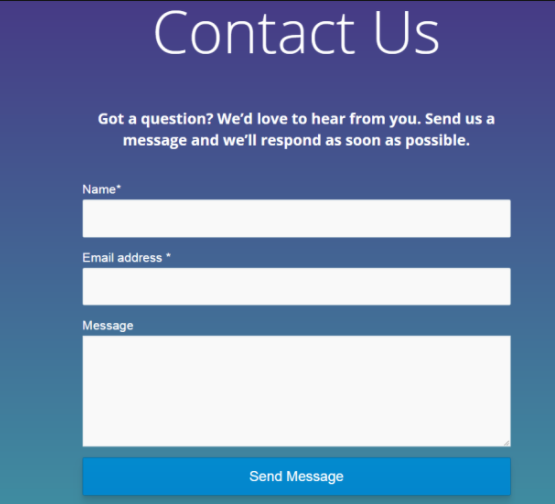
When you send a contact form, you should also keep track of it in your email correspondence (although these emails will be sent to yourself.
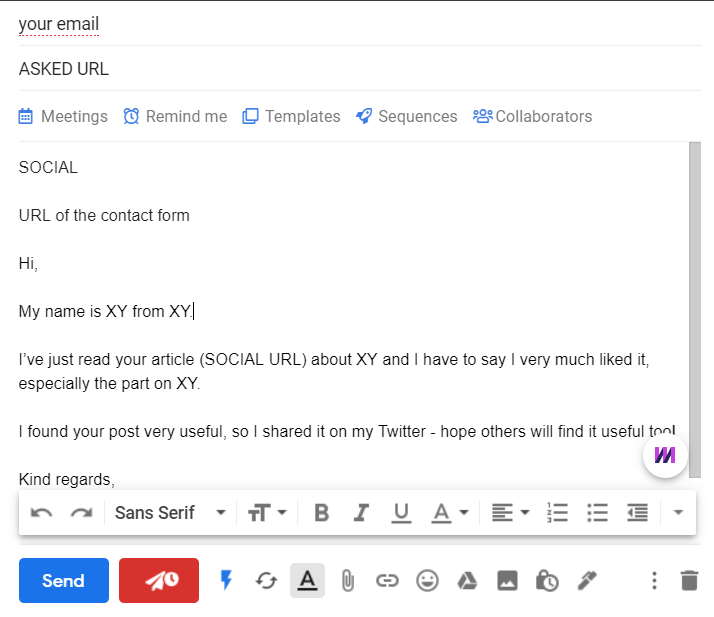
Then you send the email through the contact and to yourself as well, after which you move on to writing the ASKED email as you would on any other occasion when you have the email address, as a “forward” to yourself.
After seven days, you send the BROKEN email to the contact form.
Once it is time for the ASKED email, follow the same procedure, only now you can copy the email and paste it into the contact form after you have entered the required data.
Mind you, separate your sentences in the contact form since the majority of them won’t keep the formatting from your email.
The 1st follow-up, as well as the second follow-up, should be done in the same way.
Your email correspondence involving the contact form should look the same as any other, with the only difference in visible URLs and the fact that you have been sending the email to yourself.
More often than not you will get a response (not an automatic one). If you get an answer from another email (and the same company) de-label your emails to a contact form, label the one you get accordingly, and continue the outreach as you normally would.
Broken Link Email
The second step in our outreach strategy is when you’re going to point out an error or a mistake on a website.
In our case, what we found the most effective is to point out a broken link that the website might contain. Being that broken links are bad for users and the SEO experience, website owners usually appreciate this type of warning. Again, this is why it is important to contact the right person. They will know and appreciate you helping them out like this.
Here’s our broken link email template. Please personalize it and create your own version of this template.
Finding a broken link:
Here is the procedure on how to find the broken link
- Log in to your Ahrefs account
- Select “Site Explorer” in menu
- Put the domain name in the site search field.
- Select *.domain/* in options
- Click the search icon
- Go to the Broken links section in the sidebar menu
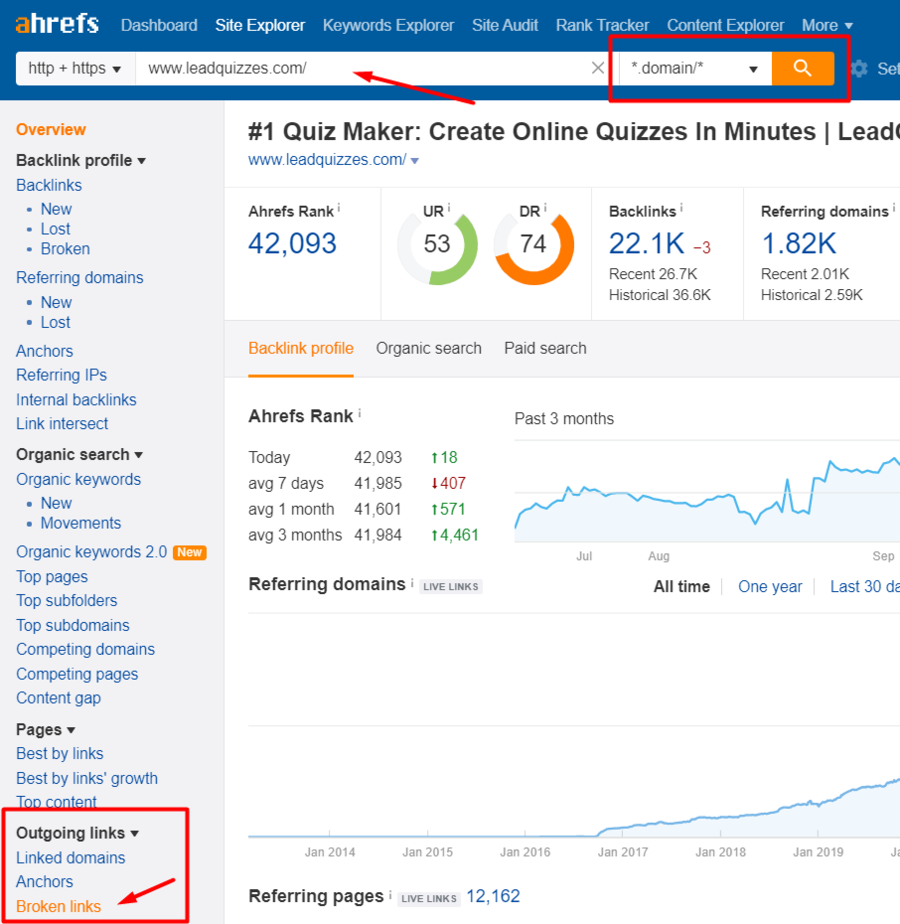
If data shows up in the right section, that means that the website probably contains a broken link and you should visit a page that sounds similar to things you’re interested in.
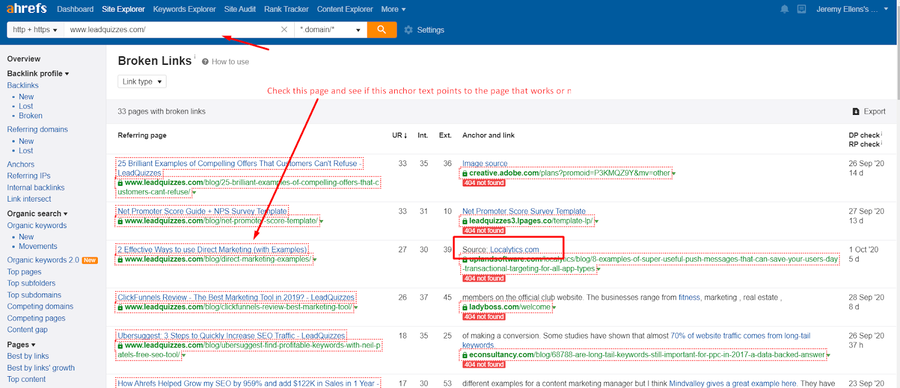
- Visit the page.
- Identify the anchor text of the broken link on page
- Click the link and verify if it’s broken or not.
- If it is broken, take a screenshot of it on the page and insert it in the spreadsheet.
- Use a tool such as Lightshot to capture a screenshot, which will also create a shareable URL that you will use in your outreach.
- If it turns out the link is not broken then find a new broken link.
- Use a tool such as Lightshot to capture a screenshot, which will also create a shareable URL that you will use in your outreach.
- If it is broken, take a screenshot of it on the page and insert it in the spreadsheet.
- Bear in mind that you should just identify broken links within the article or website pages.
- Broken links that are included within comments are not a good fit and in that case, you should just put NONE in the Broken links spreadsheet for the selected domain and skip the step.
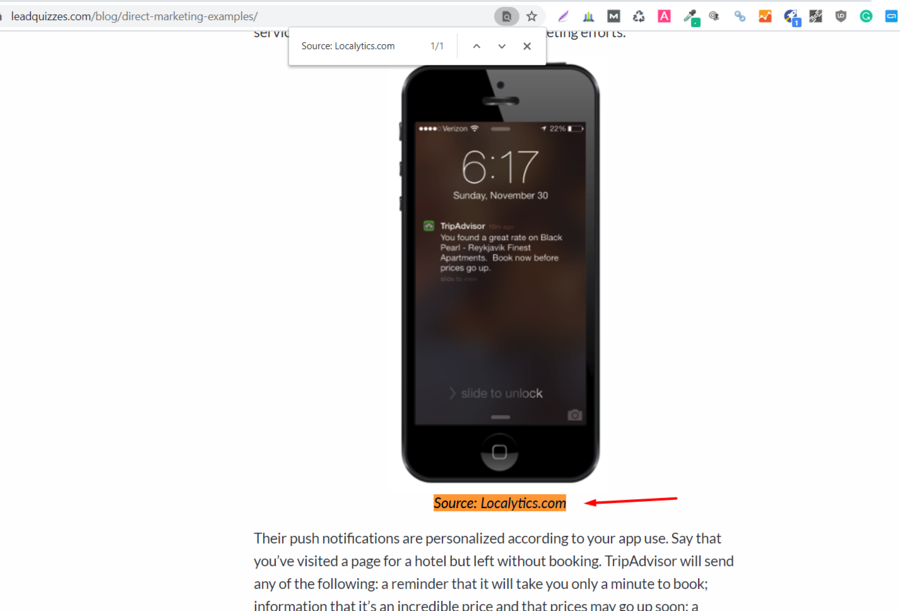
Screencast explanation of how to find broken links: https://www.loom.com/share/c9c16551bbdd4f1780872b7ecc842ec5
Asked Email
In some cases the webmaster will respond to your SOCIAL or your BROKEN email, most often to thank you.
Regardless if they have responded or not, you are going to send the so-called ASKED email, a week after you have sent the broken one. For this email, you need to find a suitable article in which you actually want to build your link. This means that the topic should be suitable and, in the best-case scenario, you have found the ideal anchor text for it.
For example, a client that offers CPR certification can search the website using the word CPR. An article like this might pop up: CPR Training: Your Guide to CPR Certification Online. Perfect topic, right? Now, in the text itself, you should be able to find a suitable anchor as well:

Now you are going to proceed by sending the ASKED email to your contacts in which you are going to suggest to them to add your link as an additional resource and point out how beneficial that is for their readers, while at the same time you tell them the most important things they should know about our client.
The email should also contain the link to the article you found. Here is an example:
Hi there,
It is Bethany again 🙂 I have spent some more time enjoying the very useful content of your website and I stumbled upon this article (link to the article here) about CPR training and courses.
I would appreciate it if you check out this website – it is an online provider of medical certification and recertification courses (CPR, BLS, ACLS, PALS…). All of the courses are flexible and accessible, they meet the necessary guidelines and standards and boast a 98% national acceptance rate in the United States.
Please, check it out using the following link: example.com
I was wondering whether you would consider presenting it to your visitors by including it on this page and making it available for them as an additional resource?
Hope to hear from you soon.
Kind regards,
Bethany
The best-case scenario is that they will agree with you and simply add your link, for free.
In other cases, they may offer a backlink exchange: they insert your link, and you insert theirs. You can determine if you’ll use backlink exchanges in your link building campaign.
The third and the most common case is that they accept to insert the link for a certain price. You should be very careful with this as it’s against Google’s policy and not a white hat method of building links.
Conclusion
Link insertions can seem like a lot of work but in reality, it’s all about finding the right people at the right websites and asking them for a small favor. However, you may not want to do all of this work yourself and you start looking for a link insertion service – and we’ll have your back.
At ReportCard, we’ve been doing link insertion and niche edits for multimillion-dollar clients around the world. Let us show you that we have what it takes to build amazing links and help you skyrocket your search engine rankings. Book your free call today!



